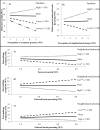Longitudinal and integrative tests of family stress model effects on Mexican origin adolescents
- PMID: 25751100
- PMCID: PMC4412805
- DOI: 10.1037/a0038993
Longitudinal and integrative tests of family stress model effects on Mexican origin adolescents
Abstract
The family stress model represents a common framework through which to examine the effects of environmental stressors on adolescent adjustment. The model suggests that economic and neighborhood stressors influence youth adjustment via disruptions to parenting. Incorporating integrative developmental theory, we examined the degree to which parents' cultural value orientations mitigated the effects of stressors on parenting disruptions and the degree to which environmental adversity qualified the effect of parenting on adolescent adjustment. We tested the hypothesized integrative family stress model longitudinally in a sample of mother-youth dyads (N = 749) and father-youth dyads (N = 467) from Mexican origin families, across 3 times points spanning early to middle adolescence. Providing the first longitudinal evidence of family stress mediated effects, mothers' perceptions of economic pressure were associated with increases in adolescent externalizing symptoms 5 years later via intermediate increases in harsh parenting. The remaining findings supported the notion that integrative developmental theory can inform family stress model hypothesis testing that is culturally and contextually relevant for a wide range of diverse families and youth. For example, fathers' perceptions of economic pressure and neighborhood danger had important implications for adolescent internalizing, via reductions in paternal warmth, but only at certain levels of neighborhood adversity. Mothers' familism value orientations mitigated the effects of economic pressure on maternal warmth, protecting their adolescents from experiencing developmental costs associated with environmental stressors. Results are discussed in terms of identifying how integrative developmental theory intersects with the family stress model to set diverse youth on different developmental pathways.
(c) 2015 APA, all rights reserved).
Figures




Similar articles
-
Transmission of cultural values among Mexican-origin parents and their adolescent and emerging adult offspring.Fam Process. 2015 Jun;54(2):232-46. doi: 10.1111/famp.12114. Epub 2014 Dec 2. Fam Process. 2015. PMID: 25470657 Free PMC article.
-
Economic hardship, neighborhood context, and parenting: prospective effects on Mexican-American adolescent's mental health.Am J Community Psychol. 2011 Mar;47(1-2):98-113. doi: 10.1007/s10464-010-9366-1. Am J Community Psychol. 2011. PMID: 21103925 Free PMC article.
-
Neighborhood and family intersections: prospective implications for Mexican American adolescents' mental health.J Fam Psychol. 2012 Oct;26(5):793-804. doi: 10.1037/a0029426. Epub 2012 Aug 6. J Fam Psychol. 2012. PMID: 22866932 Free PMC article.
-
Parenting Practices in Diverse Family Structures: Examination of Adolescents' Development and Adjustment.J Res Adolesc. 2018 Sep;28(3):650-664. doi: 10.1111/jora.12390. J Res Adolesc. 2018. PMID: 30515943 Review.
-
Families with adolescents: escaping problem lifestyles.Fam Process. 1992 Dec;31(4):341-53. doi: 10.1111/j.1545-5300.1992.00341.x. Fam Process. 1992. PMID: 1289120 Review.
Cited by
-
Parental Warmth and Developmental Change in Familism Values: Latinx Adolescents in an Emerging Immigrant Community.J Res Adolesc. 2023 Mar;33(1):202-215. doi: 10.1111/jora.12798. Epub 2022 Sep 2. J Res Adolesc. 2023. PMID: 36052477 Free PMC article.
-
The effect of increased minimum wage on child externalizing behaviors.Prev Med Rep. 2021 Nov 2;24:101627. doi: 10.1016/j.pmedr.2021.101627. eCollection 2021 Dec. Prev Med Rep. 2021. PMID: 34976680 Free PMC article.
-
How Will Higher Minimum Wages Affect Family Life and Children's Well-Being?Child Dev Perspect. 2018 Jun;12(2):109-114. doi: 10.1111/cdep.12270. Epub 2017 Nov 15. Child Dev Perspect. 2018. PMID: 29805473 Free PMC article.
-
Structural risks and family adjustment in midwestern Latine immigrant families: Extending the family stress model.Cultur Divers Ethnic Minor Psychol. 2024 Oct;30(4):815-828. doi: 10.1037/cdp0000668. Epub 2024 Apr 18. Cultur Divers Ethnic Minor Psychol. 2024. PMID: 38635222 Free PMC article.
-
Family socio-economic status and Chinese Preschoolers' anxious symptoms during the COVID-19 pandemic: the roles of parental investment, parenting style, home quarantine length, and regional pandemic risk.Early Child Res Q. 2022 3rd Quarter;60:137-149. doi: 10.1016/j.ecresq.2022.01.007. Epub 2022 Jan 31. Early Child Res Q. 2022. PMID: 35125643 Free PMC article.
References
-
- Barrera JM, Caples H, Tein J-Y. The psychological sense of economic hardship: Measurement models, validity, and cross-ethnic equivalence for urban families. American Journal of community Psychology. 2001;29:493–517. doi: 10.1023/A:1010328115110. - PubMed
-
- Causadias JM. A roadmap for the integration of culture into developmental psychopathology. Development and Psychopathology. 2013;25:1375–1398. doi: 10.1017/S0954579413000679. - PubMed
-
- Conger RD, Song H, Stockdale GD, Ferrer E, Widaman KF, Cauce AM. Resilience and vulnerability of Mexican origin youth and their families: A test of a culturally-informed model of family economic stress. In: Kerig PK, Schultz MS, Hauser ST, editors. Adolescence and beyond: Family processes and development. Oxford University Press; New York: 2012. pp. 268–286. doi:10.1093/acprof:oso/9780199736546.003.0017.
-
- Conger RD, Wallace L, Simons R, McLoyd V, Brody G. Economic pressure in African American families: A replication and extension of the family stress model. Developmental Psychology. 2002;38:179–193. doi:10.1037/0012-1649.38.2.179. - PubMed
Publication types
MeSH terms
Grants and funding
LinkOut - more resources
Full Text Sources
Other Literature Sources
Medical

